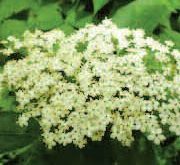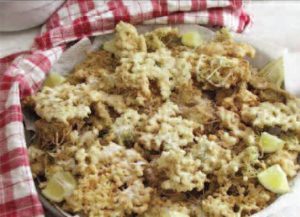Elderflower fritters: Make this decadent delight today!
 GARDEN WORKS
GARDEN WORKS
by Emily Cates
As the heat of summer settles in, the elder shrubs display their lacy flowers and fill the air with a heady scent. The wise chef makes the most of this opportunity and gathers elderflowers to make some of the most delicious fritters this world has ever indulged. Since elderflowers are common in our area, why not try them for yourself? One munch of these fritters, and you’ll be hooked! In this article, we’ll look at how to identify and cultivate this highly-esteemed shrub, how its different parts are used, and a basic recipe for elderflower fritters.
Sambucus, as this genus is called, is generally found in three different species in our area. Several species are cultivated for their fruit and also ornamental value. Ones we’ll likely encounter in the wild- S. canadensis- will be multi-stemmed, shrub-like, rarely exceeding 12ft. They’re hard to miss if you know what to look for. They are found in abundance on roadsides, in hedgerows, at the edges of woods, and in rich soils. Their pinnate leaves sport 5 to 9 sharply-toothed leaflets. Flat, umbrella-like clusters of fragrant flowers adorn the shrub starting in June, followed by clusters of small black berries. Many folks enjoy their fruits in pies, wines, jellies, jams, and medicinal extracts. S. nigra, native to Europe, have black, shiny berries that are highly regarded medicinally and made into syrups, cordials, elixirs, and other treats for the immune system. S. nigra, as well as S. canadensis and others, are commonly found as seedlings and named cultivars in various tree catalogs such as Fedco Trees.
encounter in the wild- S. canadensis- will be multi-stemmed, shrub-like, rarely exceeding 12ft. They’re hard to miss if you know what to look for. They are found in abundance on roadsides, in hedgerows, at the edges of woods, and in rich soils. Their pinnate leaves sport 5 to 9 sharply-toothed leaflets. Flat, umbrella-like clusters of fragrant flowers adorn the shrub starting in June, followed by clusters of small black berries. Many folks enjoy their fruits in pies, wines, jellies, jams, and medicinal extracts. S. nigra, native to Europe, have black, shiny berries that are highly regarded medicinally and made into syrups, cordials, elixirs, and other treats for the immune system. S. nigra, as well as S. canadensis and others, are commonly found as seedlings and named cultivars in various tree catalogs such as Fedco Trees.
Other species- which also can be found in catalogs- boast beautiful golden or powder-blue berries, while still others have lime green or black lacy ornamental leaves. A red-berried elder, which is native and flowers and fruits much earlier than the black-berried species, is not commonly used by people (but oh, the birds love it!) and is considered poisonous at least if consumed raw.
In fact, all elder shrubs have toxic parts and it would be unwise to ingest leaves, bark, roots, and unripe berries. The flowers, however, are cherished historically as a remedy for colds and flu. They also are used in baths to help break a sweat, and in skin products- particularly facial creams. Beneficial insects find a safe haven full of nourishment in elder flowers. Not only are these flowers beneficial, they are gorgeous- especially those on the dark-leaved ornamental cultivars.
Cultivation of elderberries can be mysterious- in my experience, anyways. They definitely like rich, fertile soil and full sun. Grow the mother of all elderberries on a compost heap! The shrubs that grow wild in the woods behind my house get huge and loaded with berries, but tend to die out abruptly in the next year or two. But then new seedlings take their places and round it goes again. When I dug some of these up and moved them when they were young, however, and planted them in a spot in full sun in my garden, they grew strong and stayed consistently healthy. Also, I haven’t observed this tendency in my cultivated varieties to grow as rapidly and fruit as prodigiously and then die out as the wild ones seem to- though they do appear to grow slower and fruit later in life. (What does this all mean? I’m not really sure. Any ideas?) Elderberries are pruned while the plant is dormant. Some folks cut out only dead, damaged, or diseased canes, while others cut them to the ground like perennials. I tend to apply the first option, though the fruits of the second option will be larger, but fewer.
I’ve found that bugs will not cause enough damage to destroy an elder shrub, but watch out for birds! The berries are a tasty treat for feathered foes who will strip a shrub of all ripe berries before we even know the berries are ripe. (I try to console myself with the thought that these marauding birds will be a healthy and important part of the ecosystem. Who am I to keep the beloved berries all to myself?) At any rate, the problem can be minimized with netting thrown over the shrub, or nonexistent when using the flowers. The birds and other pests leave the blooms alone. Of course, the more flowers that are harvested, the less berries there will be. But if the birds will be eating all the berries anyways, why not just use the flowers? They can be picked and dried for later use, or employed in the kitchen in pancakes and fritters.
Fritters! I promised you a basic recipe. While my ultimate goal is to eventually whip one up from locally-produced ingredients (and obviously not all of them here are), feel free to use any equivalent of these ingredients found in your kitchen if you wish. It’s really quite easy: I like to use fresh eggs, tapioca flour, sucanat, and coconut oil from Uncle Dean’s or another source of natural foods. Simply take a cut cluster of flowers that has been gently rinsed and pat dry, hold it by the stem, dip in beaten egg, again in a bowl of a mix of flour, sugar, and a pinch of salt, and fry in fat on medium heat until golden and delightfully crisp. Do this to as many clusters as you desire. Set on a plate with a paper towel to drain off excess oil, and sprinkle with cinnamon if desired. Discard large pieces of stem, and enjoy. Delicious! However you make them and whatever recipe you use, they will certainly become a seasonal favorite.
Responsible journalism is hard work!
It is also expensive!
If you enjoy reading The Town Line and the good news we bring you each week, would you consider a donation to help us continue the work we’re doing?
The Town Line is a 501(c)(3) nonprofit private foundation, and all donations are tax deductible under the Internal Revenue Service code.
To help, please visit our online donation page or mail a check payable to The Town Line, PO Box 89, South China, ME 04358. Your contribution is appreciated!


Leave a Reply
Want to join the discussion?Feel free to contribute!